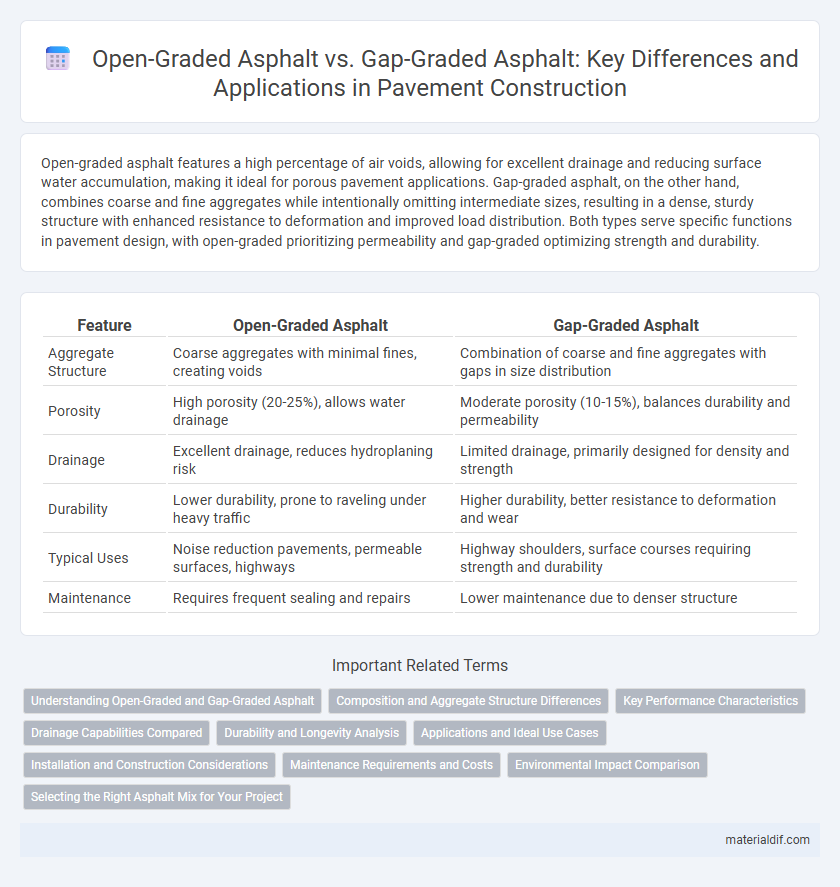Open-graded asphalt features a high percentage of air voids, allowing for excellent drainage and reducing surface water accumulation, making it ideal for porous pavement applications. Gap-graded asphalt, on the other hand, combines coarse and fine aggregates while intentionally omitting intermediate sizes, resulting in a dense, sturdy structure with enhanced resistance to deformation and improved load distribution. Both types serve specific functions in pavement design, with open-graded prioritizing permeability and gap-graded optimizing strength and durability.
Table of Comparison
| Feature | Open-Graded Asphalt | Gap-Graded Asphalt |
|---|---|---|
| Aggregate Structure | Coarse aggregates with minimal fines, creating voids | Combination of coarse and fine aggregates with gaps in size distribution |
| Porosity | High porosity (20-25%), allows water drainage | Moderate porosity (10-15%), balances durability and permeability |
| Drainage | Excellent drainage, reduces hydroplaning risk | Limited drainage, primarily designed for density and strength |
| Durability | Lower durability, prone to raveling under heavy traffic | Higher durability, better resistance to deformation and wear |
| Typical Uses | Noise reduction pavements, permeable surfaces, highways | Highway shoulders, surface courses requiring strength and durability |
| Maintenance | Requires frequent sealing and repairs | Lower maintenance due to denser structure |
Understanding Open-Graded and Gap-Graded Asphalt
Open-graded asphalt features a high percentage of air voids, promoting excellent drainage and reducing water spray on roadways, making it ideal for surface layers in wet climates. Gap-graded asphalt contains a blend of coarse and fine aggregates with minimal intermediate sizes, offering a dense structure that balances durability and flexibility for high-traffic pavements. Understanding these distinct gradation patterns aids in selecting the appropriate mix for specific performance requirements, such as noise reduction or load-bearing capacity.
Composition and Aggregate Structure Differences
Open-graded asphalt features a high percentage of coarse aggregate with minimal fines, creating a porous structure that enhances drainage and reduces surface water retention. Gap-graded asphalt combines a blend of coarse and fine aggregates with fewer intermediate sizes, resulting in a denser matrix that improves load distribution and resistance to deformation. The key difference lies in aggregate gradation, where open-graded systems prioritize void space for permeability, while gap-graded systems optimize interlock and stability through selective void filling.
Key Performance Characteristics
Open-graded asphalt offers superior permeability and excellent drainage due to its high air void content, reducing hydroplaning risks and enhancing skid resistance. Gap-graded asphalt balances durability and flexibility with a well-graded aggregate structure that improves load distribution and resistance to deformation under heavy traffic. Both types optimize pavement performance, with open-graded asphalt excelling in water control and gap-graded asphalt providing enhanced structural integrity.
Drainage Capabilities Compared
Open-graded asphalt features larger, interconnected voids that facilitate superior water drainage and reduce surface water accumulation, making it ideal for high-traffic areas prone to hydroplaning. Gap-graded asphalt has a denser structure with fewer voids, resulting in lower permeability but enhanced load-bearing capacity and durability. The superior drainage capabilities of open-graded asphalt significantly reduce hydrostatic pressure and improve pavement safety in wet conditions.
Durability and Longevity Analysis
Open-graded asphalt offers superior drainage due to its high void content, reducing water retention and minimizing freeze-thaw damage, which enhances its durability in wet climates. Gap-graded asphalt provides a denser aggregate structure that improves load distribution and resistance to rutting, resulting in extended pavement longevity under heavy traffic conditions. Durability analysis shows open-graded mixes require more maintenance in abrasive environments, while gap-graded mixtures maintain structural integrity longer when subjected to repeated mechanical stress.
Applications and Ideal Use Cases
Open-graded asphalt is ideal for high-traffic areas requiring excellent drainage and skid resistance, such as highways and airport runways, due to its porous structure that reduces water accumulation. Gap-graded asphalt suits urban roads and parking lots where a balance of durability and smooth surface is needed, offering enhanced load distribution and resistance to deformation. Both types cater to specific engineering demands, with open-graded optimizing water flow and gap-graded enhancing structural integrity.
Installation and Construction Considerations
Open-graded asphalt requires precise control of air void content to ensure proper drainage and reduce water-related damage, making compaction techniques critical during installation. Gap-graded asphalt demands careful selection of aggregate sizes to achieve a dense and stable mix, with construction methods focused on preventing segregation and ensuring uniform distribution. Both types need specialized equipment and skilled labor to optimize performance and longevity in various traffic and environmental conditions.
Maintenance Requirements and Costs
Open-graded asphalt features high permeability, reducing water retention and minimizing freeze-thaw damage, thus lowering maintenance frequency but may require more frequent surface aggregate replenishment to maintain skid resistance. Gap-graded asphalt offers a denser structure with improved load distribution, resulting in enhanced durability and reduced rutting, which can decrease long-term maintenance costs despite higher initial installation expenses. Maintenance costs for open-graded asphalt tend to be moderate due to preventive measures against water damage, whereas gap-graded asphalt often incurs higher upfront costs but benefits from less frequent repairs over its service life.
Environmental Impact Comparison
Open-graded asphalt offers superior water permeability, reducing surface runoff and minimizing hydroplaning risks, which helps in managing stormwater more effectively and lowering pollutant discharge into water bodies. Gap-graded asphalt, with its denser structure, provides greater durability but less permeability, potentially increasing surface water accumulation and urban heat island effects due to lower reflective properties. The porous nature of open-graded asphalt promotes natural groundwater recharge and reduces the need for extensive drainage infrastructure, contributing to a more sustainable urban environment.
Selecting the Right Asphalt Mix for Your Project
Open-graded asphalt offers superior drainage and reduced hydroplaning risk, making it ideal for high-traffic, wet environments. Gap-graded asphalt provides a balance of durability and flexibility, suitable for heavy load areas requiring resistance to rutting and cracking. Selecting the right asphalt mix depends on project-specific factors such as climate, traffic volume, and performance requirements.
Open-Graded Asphalt vs Gap-Graded Asphalt Infographic

 materialdif.com
materialdif.com